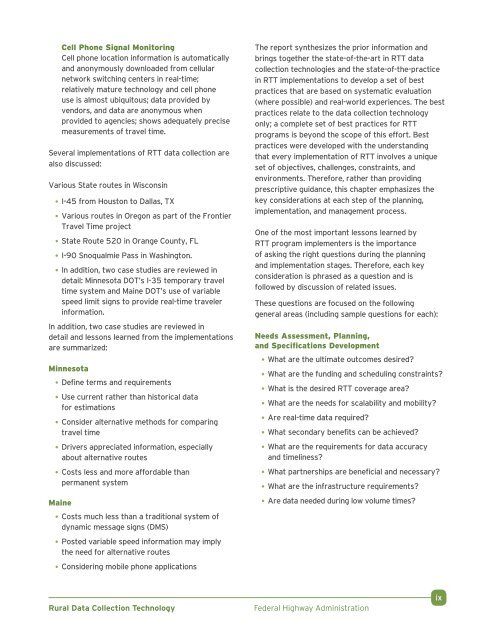To further hone the opportunity of providinguseful and accurate travel time informationin rural locations, it is important to ask thefollowing questions:1 What insights and experiences have agenciesdeveloped with these technologies, and what arethe best uses of these technologies?2 Given challenges faced in calculating and providingtravel time information on rural highways, howfeasible is deploying such technology?The core of the report discusses available andemerging RTT data sources as well as implementationconsiderations, advantages, and limitations of each.The key highlights of each follow:Bluetooth DetectionWireless technology that allows electronicdevices to communicate directly with oneanother; recently emerged as viable RTTcollection tech; open standard, allows for offthe-shelfequipment; detection range limited toabout 328 feet (100 meters); less expensivethan many other options; flexible; some potentialprivacy concerns; detection technology relies ondrivers’ use of Bluetooth enabled devices.Toll Tag ReaderDetect radio frequency ID of automated toll tags,mature technology, inconspicuous, detectionaccuracy can decrease with distance, limited toareas with adequate toll tag fleet penetration,some potential privacy concerns, electronictolling becoming increasingly common.In-pavement Magnetic Detectors .Arrays of magnetometers installed in pavement,can identify and match vehicles based on eachvehicle’s unique magnetic signature, quickinstallation and self-calibrating, wireless sensorsrequire access points and possibly repeaters,high vehicle detection rate, device life span ofabout 10 years, no privacy concerns.Automatic License Plate ReadersOptical cameras capture images of licenseplates and software “reads” the information;mature technology (over 30 years); installedabove the roadway and requires direct lineof-sight;particularly sensitive to factors thatreduce visibility; privacy issues are a concern.Machine VisionUse of video cameras to monitor flow; installedabove the roadway or on poles on the roadside;data bandwidth is a consideration; highlycustomizable set of features; privacy can be aconcern for high-resolution systems; potentialuses are likely to expand with advances intechnology, processing power, and datatransmission capabilities.Connected VehicleShort range radio communications betweenvehicles and vehicles to infrastructure,technology is in very early stages ofdevelopment, radio transceiver installed in hostdevice within a vehicle, privacy protocols arebeing established, very inexpensive cost on a perunit basis, usefulness for travel time calculationsuncertain, depends on implementation factors,potential for widespread use if initiativecontinues to develops.Radar, Microwave, and LIDARA sensor emits radio waves (radar), microwaves,or a laser beam (LIDAR), which reflects off ofvehicles, mature and widely used technology,many products available with a variety ofdifferent implementation approaches, completeprivacy to drivers.Inductive LoopsMagnetic loops in pavement detect vehiclepresence, and multiple loops can be used tocalculate travel times; mature and widelyused technology; high detection rate; veryinexpensive, but invasive installation andmaintenance can increase costs; completeprivacy to drivers.CrowdsourcingDrivers’ vehicles or mobile devices provideinformation to a public or private entity, and thatinformation is used to generate traffic/traveltime, early stage technology, critical mass ofusers are necessary for success, vehicle/motoristmust have device capable of transmittinginformation, no roadway infrastructure needed,privacy issues are minimal or non-existent whendata transmitted to agencies who purchase data,use likely to increase.<strong>Rural</strong> <strong>Data</strong> <strong>Collection</strong> <strong>Technology</strong>Federal Highway Administrationviii
Cell Phone Signal MonitoringCell phone location information is automaticallyand anonymously downloaded from cellularnetwork switching centers in real-time;relatively mature technology and cell phoneuse is almost ubiquitous; data provided byvendors, and data are anonymous whenprovided to agencies; shows adequately precisemeasurements of travel time.Several implementations of RTT data collection arealso discussed:Various State routes in Wisconsin• I-45 from Houston to Dallas, TX• Various routes in Oregon as part of the FrontierTravel Time project• State Route 520 in Orange County, FL• I-90 Snoqualmie Pass in Washington.• In addition, two case studies are reviewed indetail: Minnesota DOT’s I-35 temporary traveltime system and Maine DOT’s use of variablespeed limit signs to provide real-time travelerinformation.In addition, two case studies are reviewed indetail and lessons learned from the implementationsare summarized:Minnesota• Define terms and requirements• Use current rather than historical data .for estimations• Consider alternative methods for comparingtravel time• Drivers appreciated information, especially .about alternative routes• Costs less and more affordable than .permanent systemMaine• Costs much less than a traditional system ofdynamic message signs (DMS)• Posted variable speed information may imply .the need for alternative routes• Considering mobile phone applicationsThe report synthesizes the prior information andbrings together the state-of-the-art in RTT datacollection technologies and the state-of-the-practicein RTT implementations to develop a set of bestpractices that are based on systematic evaluation(where possible) and real-world experiences. The bestpractices relate to the data collection technologyonly; a complete set of best practices for RTTprograms is beyond the scope of this effort. Bestpractices were developed with the understandingthat every implementation of RTT involves a uniqueset of objectives, challenges, constraints, andenvironments. Therefore, rather than providingprescriptive guidance, this chapter emphasizes thekey considerations at each step of the planning,implementation, and management process.One of the most important lessons learned byRTT program implementers is the importanceof asking the right questions during the planningand implementation stages. Therefore, each keyconsideration is phrased as a question and isfollowed by discussion of related issues.These questions are focused on the following .general areas (including sample questions for each):Needs Assessment, Planning,and Specifications Development• What are the ultimate outcomes desired?• What are the funding and scheduling constraints?• What is the desired RTT coverage area?• What are the needs for scalability and mobility?• Are real-time data required?• What secondary benefits can be achieved?• What are the requirements for data accuracy .and timeliness?• What partnerships are beneficial and necessary?• What are the infrastructure requirements?• Are data needed during low volume times?<strong>Rural</strong> <strong>Data</strong> <strong>Collection</strong> <strong>Technology</strong>Federal Highway Administrationix
















